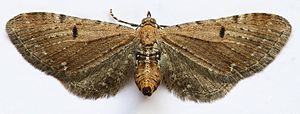Ragwort floretus
| Ragwort floretus | ||||||||||||
|---|---|---|---|---|---|---|---|---|---|---|---|---|

Ragwort pachyderm ( Eupithecia absinthiata ), female |
||||||||||||
| Systematics | ||||||||||||
|
||||||||||||
| Scientific name | ||||||||||||
| Eupithecia absinthiata | ||||||||||||
| ( Clerck , 1759) |
The ragwort fly ( Eupithecia absinthiata ), sometimes also called wormwood fly , is a butterfly ( moth ) from the family of the flyers (Geometridae). The specific epithet refers to wormwood ( Artemisia absinthium ), a food plant of caterpillars. The type was used as Phalaena absinthiata Clerck described in 1759 and is the type species of the genus of the Pug ( Eupithecia ).
features
butterfly
The wingspan of the moth is 15 to 30 millimeters. The basic color of all wings varies from light gray to brown gray. On the upper side of the forewing, some blackish spots stand out on the front edge . An elongated black discoidal spot stands out clearly. The wavy line is broken up into white dots and ends in a small white spot in the inner corner . The root field of the hind wings is slightly lightened. The fringes of all the wings are not checked.
Caterpillar
Adult caterpillars are smooth and elongated. They adapt in color to the basic color of the respective food plant and are accordingly greenish, cream-colored or brownish in color and usually show a red-brown diamond-like pattern on the back. Sometimes there are also light green specimens that are almost without drawings.
Doll
The yellow-brown pupa is provided with greenish wing sheaths. There are eight hook bristles on the cremaster , the middle pair of which is strong.
Similar species
The wavy line as well as the white spot in the inner corner are clearly developed in the case of the hops-pod ( Eupithecia assimilata ). The fringes are piebald. In the case of specimens that have flown away, a reliable determination is usually only possible by means of a genital morphological examination.
Distribution and occurrence
The species is distributed throughout Europe including the British Isles and in large parts of Asia to Japan . There is also an occurrence in North America.
The ragwort moth occurs in all major natural areas, partly across the country as well as in metropolitan areas. In the Southern Alps it rises to heights of 1,600 meters.
Way of life
The crepuscular and nocturnal moths reach their main flight time in July and August. Depending on the flower development of the respective host plant, however, different flight times were found. They like to visit artificial light sources . The flowers of the golden aster ( Galatella linosyris ), bed herbs ( Galium ), widow flowers ( Knautia ), clover ( Trifolium ) or umbelliferae serve as a food source for the butterflies . The caterpillars, which live in September and October, feed polyphagously on the leaves, flowers and fruits of a large number of different plants. A certain preference was for Cross herbs ( Senecio ), Eupatorium ( Eupatorium ) and of goldenrod - ( Solidago ) and Artemisiaarten found. The species overwinters in the pupal stage.
Danger
The ragwort moth is widespread and usually numerous in Germany and is classified as “not endangered” on the Red List of Endangered Species .
Individual evidence
- ^ Arnold Spuler: The butterflies of Europe , Volume 2, E. Schweizerbart'sche Verlagsbuchhandlung, Stuttgart, 1910, p. 74
- ↑ Vladimir Mironov: The Geometrid Moths of the World . In: Axel Hausmann (Ed.): The Geometrid Moths of Europe . 1st edition. Volume 4: Larentiinae II. Perizomini and Eupitheciini . Apollo Books, Stenstrup 2003, ISBN 87-88757-40-4 (English). , Pp. 278-281
- ↑ a b c d Günter Ebert (Ed.): The butterflies of Baden-Württemberg. Volume 9. Moths VII. Geometridae 2nd part . 1st edition. Ulmer, Stuttgart (Hohenheim) 2003, ISBN 3-8001-3279-6 . , Pp. 175-178
- ↑ Locations in North America according to information from Mississippi State University
- ^ Karl Cleve: The butterflies of West Berlin , Berliner Naturschutzblätter, Volksbund Naturschutz e. V., Volume 22, No. 63, 1978, p. 364
- ↑ Walter Forster , Theodor A. Wohlfahrt : The butterflies of Central Europe. Volume 5: Spanner. (Geometridae). Franckh'sche Verlagshandlung, Stuttgart 1981, ISBN 3-440-04951-5 , pp. 167-168.
- ↑ Manfred Koch , Wolfgang Heinicke, Bernd Müller: We determine butterflies. Volume 4: Spanner. 2nd, improved and enlarged edition. Neumann, Leipzig / Radebeul 1976, DNB 780451570 , pp. 170-171.
- ↑ Endangerment
literature
- Vladimir Mironov: The Geometrid Moths of the World . In: Axel Hausmann (Ed.): The Geometrid Moths of Europe . 1st edition. Volume 4: Larentiinae II. Perizomini and Eupitheciini . Apollo Books, Stenstrup 2003, ISBN 87-88757-40-4 (English).
- Günter Ebert (Ed.): The butterflies of Baden-Württemberg. Volume 9. Moths VII. Geometridae 2nd part . 1st edition. Ulmer, Stuttgart (Hohenheim) 2003, ISBN 3-8001-3279-6 .
Web links
- Lepiforum e. V. - Taxonomy and photos
- kolumbus.fi - caterpillar


